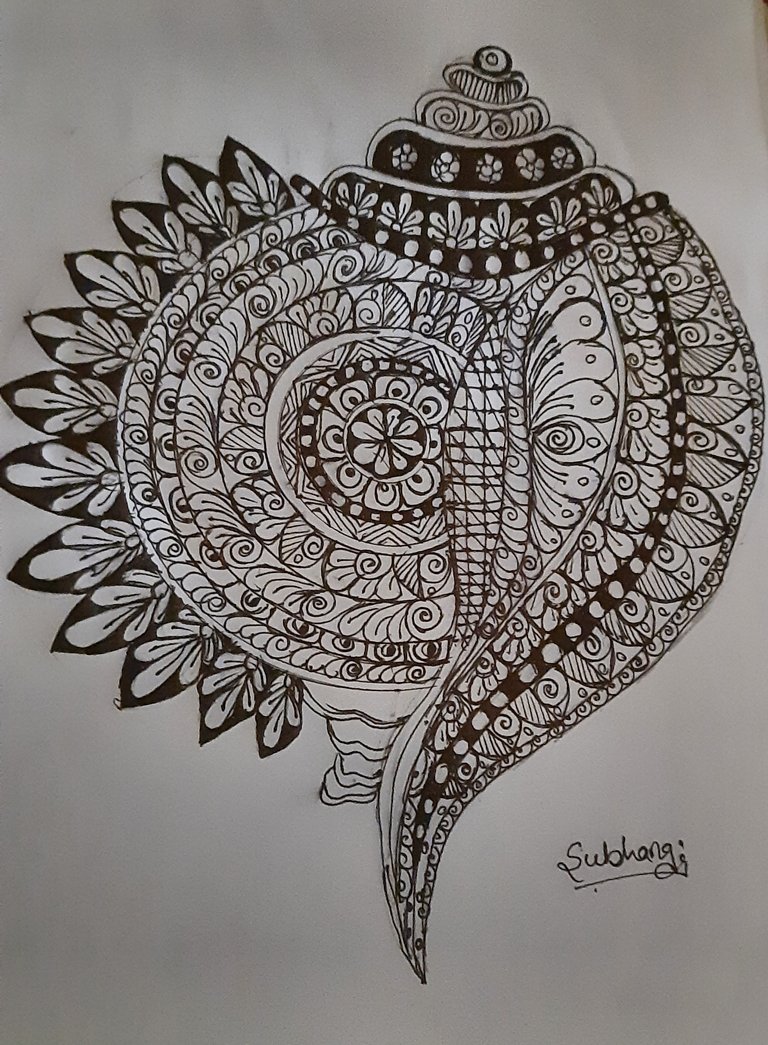Hello,
I'm fine, how about you all?
I'm hoping everyone is doing great. Also, I'm doing fine.
In today's blog, I'll show you a recent black-and-white drawing of Mandela that I made. That is the mandala art of SHANKH.

So let's examine Mandela's artwork from today.
I attempted to organize the processes as I went along so that you could see how I sketched the picture. Each step is described below. I'm hoping you like it.
Required materials:
- white paper
- black color pen
- geometric compass

A conch shell was used to make the shankh, a wind instrument used in religious rituals. In Orissa, one might find this instrument. Although it only has a few musical uses, the shankh is regarded as having great religious significance in Hinduism.

Each Hindu temple has a conch shell on display. It also has significant spiritual importance to other religions. Hindu holy texts claim that during the Samudra Manthan, conch shells first appeared on land. Just before the goddess, Lakshmi was to come, it appeared. Lord Vishnu accepted it, and even then, it has been depicted in one of his hands.
Numerous Hindu deities are thought to live in conch shells. On the surface of the shankh, for instance, are Lord Brahma, the Sun God, and the Moon God. On the right are Aditya, Varun, Soma, Vayu, and Agni. The presiding deities are Chandra Dev and Surya Dev. Prajapati is seated in the back, while Varun is the conch's god. Ganga and Yamuna, goddesses of the rivers, are shown in the front. So veneration of the conch shell has profound religious significance.

According to the Skanda Purana, we can atone for the sins of our seven lives by bathing the idol of Lord Vishnu in a shankh. According to the Varsha Purana, taking a bath with the Dakshinavarti Shankh helps atone for our misdeeds. According to the Sankha Sadma Purana, bathing in the Holy Ganga River is equal to pouring water with a shankh over our heads in front of the image of Lord Vishnu. In addition to this, the Bhagavad Gita and Mahabharat provide detailed explanations of the significance of shankh. The blowing or maintaining of a conch has both scientific and religious justifications.

Significance of Shankh or Conch:
There have been several uses for shankh over the years. Their morning blowing signaled the start of the conflict. They signaled the end of the day's fighting in the evening. After a war, when they were destroyed, it represented a triumph.

Scientific Significance of Shankh or Conch:
When you place a Shankh close to your ears, you can hear a gentle humming of the ocean. It is because of the shape of the spirals in the shankh.

The sound from shankh is soothing and can enhance your vitality.
It also has advantages for the environment. It contributes to lessening pollution and is essential for the ozone layer's recovery. The positive energy that flows through your mind and body can be increased by listening to the sound made by a shankh. It has the capacity to produce psychological vibrations that could increase your bravery, willpower, and hope.
Types of shankh:
Different types of shankhs are auspicious in Hinduism. They are:
1.Dakshinavarti Shankh
2.Vamavarti Shankh
- Gaumakhi Shankh
4.Ganesh Shankh
5.Kauri Shankh
6.Moti Shankh
7.Heera Shankh
